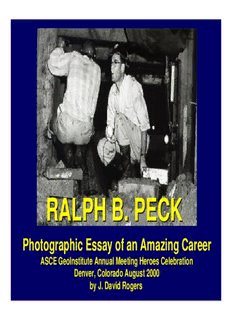
Ralph B. Peck: Photographic Essay of an Amazing Career PDF
Preview Ralph B. Peck: Photographic Essay of an Amazing Career
RRAALLPPHH BB.. PPEECCKK Photographic Essay of an Amazing Career ASCE GeoInstitute Annual Meeting Heroes Celebration Denver, Colorado August 2000 by J. David Rogers PECK’S FORMATIVE YEARS 1912 - 1930 A DETERMINED YOUNG MAN Ralph Peck (third from left) about the time he decided to become a civil engineer (1924). His 6th Grade teacher, Miss Knight, asked her students to write an essay on what they aspired to do upon reaching adulthood. She told Ralph he’d have to take mathematics more seriously if he intended to become an engineer. In his father’s footsteps Orwin and Ralph Peck in the back yard of their Denver home,circa 1933. Orwin was graduate of Dakota Wesleyan (B.A., 1904), who went on to engineering school at the University of Wisconsin, graduating in late 1907, with a B.S. in general engineering. He worked for a number of railroads before coming to the Denver & Rio Grande Western in Denver as a Bridge Engineer in 1921. He served as a consultant on the Royal Gorge suspension bridge, completed in 1929 as the world’s highest span. Orwin was promoted to Engineer of Structures in 1939, and remained with the Rio Grande for the balance of his career, retiring in 1956. The Peck home at 825 Garfield Street in Denver It was here that Ralph spent most of his formative years. An only child, he lived with his parents and maternal Grandmother Huyck. The small family enjoyed singing hymns together in the evenings, and Ralph inherited his father’s knack for playing the piano by ear, but not his father’s deep bass singing voice. Much later, Karl Terzaghi visited the senior Pecks when he came to Denver. HONING MATH AND MUSIC SKILLS Still determined to become a civil engineer like his father, Ralph (at left) completed a challenging course in algebra taught by Miss Willins in the 7th Grade, and received his first set of glasses (1925- 26). Ralph began playing the piano in the 5th Grade, playing duets with his father. He continued playing in the symphony orchestra through high school. A SOCIAL LIFE CENTERED ON CHRISTIAN YOUTH GROUPS Ralph (second from right) met Marjorie Truby (second from left) at their Christian Endeavor Group in the Capitol Heights Presbyterian Church in Denver, when both were in Jr. High School. Marjorie was two years younger than Ralph. WORKING WITH SOILS ON A SIGNAL GANG Ralph’s first exposure to “soils” was as the junior member of a Denver & Rio Grande Railroad signal gang, performing trackside work during the summer following high school (1930). The job paid 55 cents per hour, just 20 cents an hour less than he would make 7 years later at American Bridge, with a doctorate in structural engineering. Most of his work involved using a shovel, which made college look pretty good by the end of the summer. Ralph thinks that was his father’s intent. CCOOLLLLEEGGEE DDAAYYSS RReennsssseellaaeerr PPoollyytteecchhnniicc IInnssttiittuuttee SSeepptteemmbbeerr 11993300 -- JJuunnee 11993377 Off to RPI On September 5, 1930 Ralph and Marjorie said their good- byes as he departed for college. He was 18 and Marjorie 16 at the time. Turning down scholarships to the University of Colorado and Colorado School of Mines, Ralph enrolled at Rensselaer Polytechnic Institute in Troy, New York because his father knew that many of the country’s finest bridge engineers had attended RPI. At that time RPI’s student body was all male.
Description: